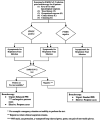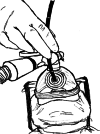The use of pediatric flexible bronchoscopy in the COVID-19 pandemic era
- PMID: 33730395
- PMCID: PMC8251429
- DOI: 10.1002/ppul.25358
The use of pediatric flexible bronchoscopy in the COVID-19 pandemic era
Abstract
On March 11, 2020, the World Health Organization (WHO) declared the pandemic because of a novel coronavirus, called severe acute respiratory syndrome coronavirus 2 (SARS-CoV-2). In January 2020, the first transmission to healthcare workers (HCWs) was described. SARS-CoV-2 is transmitted between people because of contact, droplets, and airborne. Airborne transmission is caused by aerosols that remain infectious when suspended in air over long distances and time. In the clinical setting, airborne transmission may occur during aerosol generating procedures like flexible bronchoscopy. To date, although the role of children in the transmission of SARS-CoV-2 is not clear the execution of bronchoscopy is associated with a considerably increased risk of SARS-CoV-2 transmission to HCWs. The aim of this overview is to summarize available recommendations and to apply them to pediatric bronchoscopy. We performed systematic literature searches using the MEDLINE (accessed via PubMed) and Scopus databases. We reviewed major recommendations and position statements published at the moment by the American Association for Bronchology and Interventional Pulmonology, WHO, European Center for Disease Prevention and Control and expert groups on the management of patients with COVID-19 to limit transmission among HCWs. To date there is a lack of recommendations for safe bronchoscopy during the pandemic period. The main indications concern adults and little has been said about children. We have summarized available recommendations and we have applied them to pediatric bronchoscopy.
Keywords: COVID-19; SARS-CoV-2; children; flexible Bronchoscopy; healthcare workers.
© 2021 Wiley Periodicals LLC.
Figures




References
-
- World Health Organization . Coronavirus disease (COVID‐2019) situation reports. situation report – 1, 2020. Available from: https://www.who.int/docs/default-source/coronaviruse/situation-reports/2...
-
- World Health Organization . Director‐General's opening remarks at the media briefing on COVID‐19 ‐ 11 March 2020. Available from: https://www.who.int/dg/speeches/detail/who-director-general-s-opening-re...
-
- World Health Organization . Coronavirus disease (COVID‐2019) situation reports. situation report – 128, 2020. Available from: https://www.who.int/docs/default-source/coronaviruse/situation-reports/2...
-
- Chan JYK, Wong EWY, Lam W. Practical aspects of otolaryngologic clinical services during the 2019 novel coronavirus epidemic: an experience in Hong Kong. JAMA Otolaryngol Head Neck Surg. 2020;146(6):519‐520. - PubMed
Publication types
MeSH terms
Substances
LinkOut - more resources
Full Text Sources
Other Literature Sources
Medical
Miscellaneous

